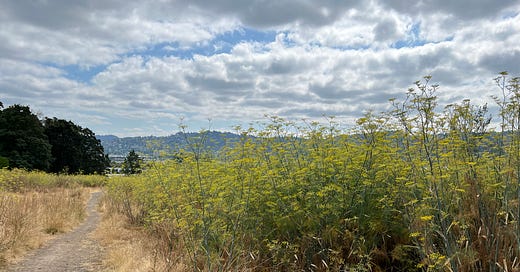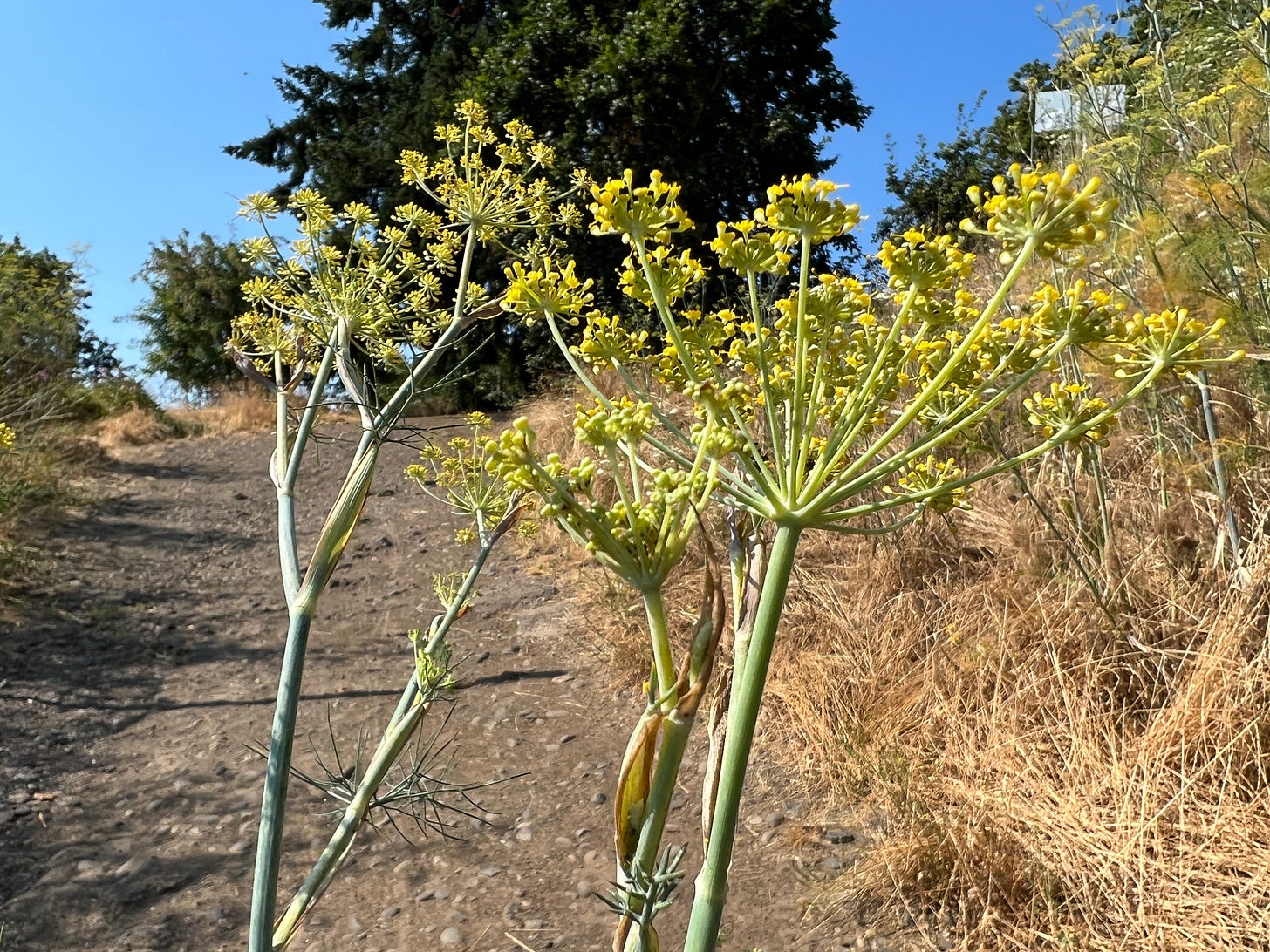A few weeks ago, in the middle of a 100-degree week, I walked down to the two-acre stand of wild fennel that has taken over the dog park on the bluffs near my home. The neighbors have carved paths though this aromatic forest, and as I wandered amid the 8-foot-high weeds the tiny galaxies of yellow flowers thrummed with the drone of thousands of bees. At age 10, the sound would have terrified me, but at 50, it has become an apian sound bath, one that my body responds to in unconscious, sympathetic vibration.
Over the three decades that I have lived on the West Coast, the smell of wild fennel on hot summer days has become as familiar as the salt-scrubbed coastal air. Fennel clumps up around vacant lots and roads all over the Bay Area. Its fragrance, blended with that of California bay and eucalyptus, was the smell of the long bike rides I used to take in the Marin hills. Even after I learned that wild fennel belonged to the same species, Foeniculum vulgare, as the fennel bulbs I shaved into my salads, I didn't give it much thought. It was simply part of the scenery, ubiquitous and neglected. When I moved north, however, and spotted fennel sprouting along Portland's sidewalks and bluffs, it signaled some continuity with my old life: new ecosystem, same invasive weed.
In the three years that I have lived near the Dog Bowl, the fennel forest has become more dense. Perhaps the drought and last year's extreme temperatures have made North Portland's bluffs more inhospitable to native plants, letting the Mediterranean transplant crowd them out. Perhaps fennel is the equivalent of green-lipped mussels and, well, humans, an ambitious species with a knack for carpe'ing the diem.
The state of California attributes the weed’s spread to cultivated fennel that went feral in the state more than a century ago. According to the California Invasive Plant Council, no one really knows the role wild fennel might play in its new home—a transitional invasion that will be replaced by another species? A permanent takeover? So far, the most successful strategy for clearing a wild fennel stand like the one in the Dog Bowl has been to burn it out, then douse the area with herbicides for a few years. I can't imagine even one of my neighbors backing that plan.
Oregon seems content to blame wild fennel on California (naturally), but the state's Noxious Weed Control program doesn't consider it a noxious weed on the same level as goat's rue or butterfly bushes. When I emailed the program to ask why, Beth Myers-Shenai, an invasive plant specialist, responded in an email, "Although wild fennel is abundant in Portland it is rarely observed disturbing healthy, intact natural areas or causing a large amount of economic damage." In other words, we're content to consider wild fennel innocuous because doesn't disrupt capitalist extraction from the land or the designated wilderness zones where we allow "nature" to flourish for our own appreciation. (That might be a touch cynical.)
There's something to be said for the pleasure of wandering down to the fennel forest with a pair of clippers, basking in the heat and the bee hum and the fragrance of millions of tiny yellow blossoms. I wandered back home clutching a giant cloud of fennel flowers, one persistent honeybee joining me on my route.
Before moving to the West Coast, I had never tasted fennel. Over the past three decades, I've grown to love its flavor, which is warmer and more complex than licorice and anise. Raw, the shaved bulbs punctuate a salad with their delicate, anise-tinged crunch; cooked, fennel melts into the other flavors of a dish without trying to dominate them. Fennel's flavor seems to float away as soon as it hits. It doesn't cling to the back of the throat.
According to all the Mediterranean and West Coast recipes I scrolled through online, the best time to harvest wild fennel's tender green fronds was months ago. Other recipes suggested I wait another few more weeks to harvest the fennel pollen, but I’ve discovered that it makes my throat swell up. I decided to trim and wash the fennel flowers and straggly fronds I brought home to make Georgia Di Sabatino's recipe for southern Italian fennel digestivo.
To be honest, I didn't really follow the recipe. I just filled a Mason jar with vodka, fennel flowers, fronds, and a few green fennel seeds I'd stuck in the freezer last fall (another project whose purpose I've forgotten). After 10 days, I strained the golden liqueur off the herbs and added simple syrup.
When I sipped a test spoonful of the liqueur, the anise sounded a strong, pure note. As it faded, though, that grassier, gentler undertone I love emerged. I stuck the bottle in the back of the cabinet to mellow for a few months, but forgot to wipe up a few drops that spilled onto the countertop. By the time I woke up the next morning, the kitchen smelled like a Portland hillside on a hot August afternoon.








I had no idea you could consume those weeds or even what they were. Thank you for educating me!